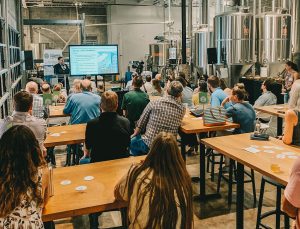On the evening of July 12, 2022, Missouri Gateway Green Building Council hosted our monthly educational program with Building Energy Exchange St. Louis, a project of Missouri Gateway Chapter, at Rockwell Beer Company. Fueled by delicious appetizers and an open bar, the 53 attendees of the event listened to speaker Aaron Michels, Director of Operations at Energy Resources Group, Inc., discuss energy efficiency and energy inefficiency. Michels’ presentation first defined for us what the split incentive problem is, before going into consequences, case studies, and potential remedies of the issue. As defined by Michels,
the split incentive problem is when landlords lack the appropriate incentives to implement energy efficiency measures, not only costing their tenants money, but also negatively impacting the environment by releasing more pollutants than necessary.
Michels also highlighted how low-income tenants face energy poverty or a higher energy burden, meaning they allocate significantly more of their household income to energy expenditures than other renters. Since tenants have little power in the rental arrangement, this is a difficult situation to absolve.

However, Michels did provide some ideas for eliminating the issue. First, he proposed a need for increased awareness, education, and outreach among owners, tenants, and the brokerage community about the value of green leases. A green lease, in simple terms, is
a rental agreement whereby a tenant shares the cost burden of sustainability initiatives with the building owner1.
These initiatives include expenses such as water and energy conservation, waste reduction, and recycling. Initially these investments will likely infer a cost on the parties, but will ultimately lead to savings down the line, as energy bills can be greatly decreased.
Another remedy could be energy efficiency mortgages (PACE financing)—externally funded loans attached to the property. A benefit of this action is that capital improvements can be done at one time but paid off in installments. A third solution is on-bill financing, where capital improvements are tied directly to utility company payments and for large residential; increased incentives to counter the split incentive. On a more macro level, green building codes can be stricter, which has the potential to benefit all new housing developments, including buildings for low-income tenants. An additional policy response that has the potential to be effective is a weatherization assistance program, engaging tenants to help improve their leased space.

After we had a clear and comprehensive perspective on the split incentive problem, members had the opportunity to ask questions to a series of panelists who are experts in their field. The panelists included:
- Kevin Bryant, Executive Founder, Developer & President of Kingsway Development
- Jon Nichols, Director of Sustainability at Antheus Capital & Mac Development
- Tristan Walker, Principal of Heritage Properties St. Louis
There were many questions ranging from “how can landlords/management companies be incentivized to improve energy efficiency” to “what can individuals do if they have a short-term lease, but still want to improve energy efficiency.”
It was clear from the diversity and number of questions that the audience was engaged and excited to learn about the tangible changes that can be made to improve our energy footprint. I believe it is fair to say that every attendee left the program with new ideas and hope for a more equitable and environmental future. If you were not able to attend this event and would like to see what you missed, view the July 12, 2022 program recording, Solving the Split Incentive Problem – Reframing Investment in Energy Efficiency for Building Owners & Tenants.
Sources:
Bird, S., & Hernández, D. (2012, September 1). Policy options for the split incentive: Increasing energy efficiency for low-income renters. Energy policy. Retrieved August 3, 2022, from https://www.ncbi.nlm.nih.gov/pmc/articles/PMC4819331/
Building Energy Performance Standards Info Session – Building Energy Exchange St. Louis, City STL. YouTube. (2022, July 23). Retrieved August 3, 2022, from https://youtu.be/2i8cK095ZL8
YouTube. (n.d.). Usgbcmogateway YouTube. YouTube. Retrieved August 3, 2022, from https://www.youtube.com/channel/UCMyElVIJligezzBnnIOsORw
A reflection post of the July evening educational program, “Solving The Split Incentive Problem – Reframing Investment in Energy Efficiency for Building Owners & Tenants” with resource links and live event recordings; written by Avery McCammon, Washington University in St. Louis undergrad student, summer 2022.
